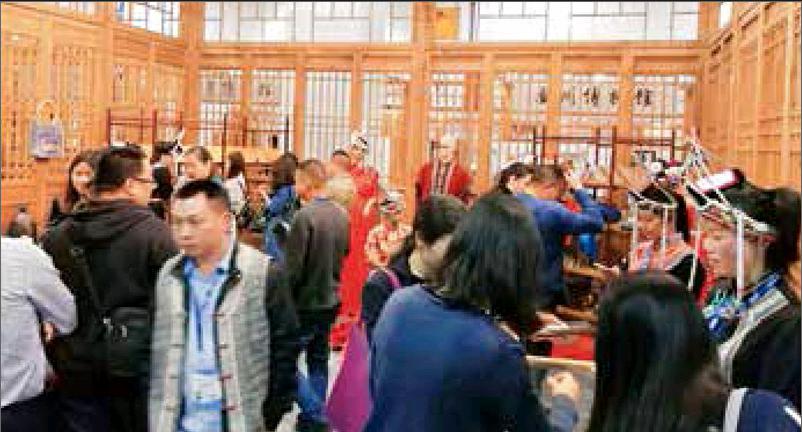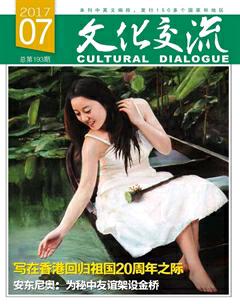小商品之都的文化嬗變
魏水華

前不久,在浙江衛視播出的一部電視劇《雞毛飛上天》火了,義烏人津津樂道。在他們看來,“雞毛換糖”傳統所反映出來的浙商的創業精神,正是義烏文化的特質。
這個小商品之都——曾經作為“中國制造”走出去的前沿陣地,在經歷了十幾年的磨練、變遷之后,也正在發生耀眼的改變,變成“中國智造”的興起與傳播之地。
最近在義烏舉行的第十二屆中國文化產品交易會正是折射這種文化嬗變的精彩呈現。
從創意到產業
在文交會現場的江西省博物館展區,一組取材于南昌西漢海昏侯墓葬出土文物的“再現海昏”系列文創產品首先吸引了我的目光。
“再現海昏”由文房清供、愫居逸品、數碼尚品、青銅臻品四大系列衍生品組成,汲取南昌西漢海昏侯墓葬出土珍品之精髓,通過時尚人文的設計理念,將實用與審美巧妙結合,使得深藏博物館的江西漢代經典藝術珍品,走進大眾一展“芳容”。
品牌負責人王思齊介紹了他們如何進行二次設計的經過:“海昏侯現是熱門,我們從江西考古研究所拿到授權后,就立即進行開發,并選取玉神獸作為主推的設計元素,是因為它非常喜感,更符合年輕人的口味。”
其實,“再現海昏”并不是個例,本屆展會匯集包括中國國家博物館、首都博物館、浙江省博物館等在內的國內博物館、美術館行業領軍單位參展,共有80多家博物館和美術館帶著他們的衍生品,以文化創意衍生品的形式來講述文物背后的故事。組織者之一的中國文物交流中心副主任周明說:“展品主要是博物館的藏品、文化遺產的資源。因為中國是歷史文明古國,歷史悠久,文化璀璨,擁有非常豐富的文化遺產,這些是我們做文化創意的無盡源泉,有中國傳統文化元素的滋養。我們都知道義烏的設計團隊、研發團隊和制造團隊都是非常強的,而且義烏是世界小商品集散的一個樞紐。這是我們文物交流中心第一次大規模地出面組織文博單位來參加展會,主要希望我們文博單位的產品優勢能夠與義烏的生產銷售優勢得到更好的結合,推動文博文創產業進一步發展,不單是在國內發展,也能走向世界。”
除此之外,4DX、數碼版畫、陶瓷油畫……新技術、新概念讓人目不暇接;老字號也不甘寂寞,今年文交會特設“非遺和工藝美術展區”,為東陽木雕、桐鄉藍印花布等非遺的傳承保護和二次開發搭建優質平臺。浙江省非遺衍生品生活主題館以“再現·再造·再生”為主題,強調非遺衍生品與大眾生活、商業貿易融合發展的重要性;中國美院打造的“最設計”展區更是首次將設計課堂搬入展廳,客商、顧客在選購商品的同時能看到一件件文創產品的“生產流水線”。
一切的精彩,似乎都在敘述著,義烏已經有能力,把才華、創意變成成熟的產業,而這,正是當初那個“小商品之都”最缺乏的地域特色和原創能力。
從代工到原創
“不倒翁”茶杯、補水儀、手觸離子燈、水舞燭……在國際商貿城的義烏小樣達客網絡科技有限公司展示區中,一系列外觀時尚、設計新穎的家具產品引得顧客紛紛駐足。
觀察近幾年的文交會,商品越來越新穎別致,文化滲透力越來越強。
義烏有著發達的商品資源,集聚著7.5萬個商戶、25萬家中小企業,號稱“只有你想不到的,沒有你買不到的”。過去,義烏小商品一直是單純生產加工,沒有自己的創意設計,附加值很低。想要轉型,義烏必須擺脫創意設計缺失、文化味不足的短腿,但困難重重:當地的文創團隊雖說不少,但大多被市場牽著走,創意水平不高,而且更多商戶習慣了模仿。義烏創新設計產業協會會長李丹坦言:“時間一長就被人家仿造走了。”
“邁出第一步是最難的,因為創意、設計不會在短期內給商家帶來利益。”義烏法藍文化創意有限公司運營長助理王超男說,公司自2015年入駐義烏國際商貿城以來,目標是為小商品廠家、商戶提供一個和設計師對接的平臺。現在,越來越多小商品生產商看到了“文創”的重要性。
事實上,義烏文交會在2014年第9屆轉型升級之際,圍繞文化產業“新業態、新技術、新產品、新概念、新工藝、新設計”的“六新”概念,緊緊抓住文化創意和設計服務的融合特性,已經開始打造全產業鏈生態化營銷模式了。
文化創意和設計服務作為紐帶,不僅為傳統生產企業提供優質的創意、產品設計、包裝設計、工業設計等,促進產品附加值提升,而且還為動漫游戲企業衍生品開發、文化文物單位文創產品開發、非遺和工美領域的中國傳統文化元素二次開發創意產品提供服務。同時,又可以獲得第一手市場反饋信息,了解市場需求,并且通過生產企業熟悉文化產品領域的工藝流程、工藝特點等訊息,從而降低設計成本和研發成本。另外,開發出來的動漫游戲衍生品、文化文物單位文創產品、非遺和工美創意產品,為生產企業提供了市場“新藍海”。
是的,一個曾經只是“代工廠”的地方,已經成為原創文化輸出、版權資源豐富的“文化金庫”。
從外銷到交流
本屆文交會上,另一個有意思的場景是一場由國際木文化學會組織的木雕展。64個國家90位藝術家的200余件作品,風格各異,體現出濃郁的民俗傳統、精神氣質和匠心獨運。此外,還有“一帶一路”國際藝術展也吸引了不少人的目光。藝術展匯集了來自俄羅斯、烏克蘭、西班牙、意大利、波蘭以及中國的多位寫實主義油畫大師在各個時期的30余幅優秀作品,令藝術愛好者們驚喜不已。
相比往屆,此次展會更加國際化。在一會之內飽覽各國風情,讓很多客商也發現了商機。
“之前沒有想到這次來能看到這么多國家的文化展,收獲很多。”來自衢州的客商鄭子陽說,自己從事與中美文化商貿交流相關的工作,因為文化的差異,如何把美國文化“本地化”是他最頭疼的問題,“看到國外的展覽反響竟然能這么好,對我也有一些啟發。”
曾經單純的外銷,今天是既有“走出去”、又有“引進來”的對外交流,其背后,就是在轉型當口,義烏人開始思考,自己所處的這座城市,文化特質究竟是什么,文化根基在哪?難道,只是那如山如海一般的小商品嗎?
深厚的商業傳統為義烏的文化發展勾畫了大致的輪廓與方向。而更密切的國際文化交融、更深刻的傳統文化發掘,正在義烏悄然勃興。顏烏故里、二喬故里、駱賓王墓、容安古堂等文化資源像珍珠般串兜在義烏大地上,傳統底蘊豐厚。
有專家說,義烏文交會搭建創意與產業碰撞的平臺,這里不單單是文化產品和文化活動的秀場。當創意設計與文化產業相遇,呈現的是一種融入生活的時尚理念。
從小商品之城,再到“產品+文化”,最后到城市的氣質塑造。當12歲的文交會與義烏的融合越來越深入,小商品之都的文化嬗變的燦爛前景也就更加值得期待。
Yiwu, a city in central Zhejiang, is now a star city at home and abroad. It is best known as the worlds largest marketplace of household commodities. It has been exporting small commodities all over the world. As the Belt & Road Initiative is going all the rage, Yiwu is now a key departure port for made-in-China commodities transported by the rail all the way through the Eurasia to reach various destination cities such as Madrid and London in Europe. The city has witnessed tremendous changes that have taken place in China and transformed the ancient oriental country thanks to the modernization drive since the late 1970s.
As a marketplace, Yiwu has seen tremendous changes in itself. It has grown in size, and it has upgraded itself many times; the goods it sells to the world have increased in great variety and quantities; they are of better quality and better design; and its reach into the world has become wider, deeper, and broader.
Innovative designs have been appearing in greater numbers, adding a special cultural touch to the goods China makes and trades to the world, as teied by the 12th China Cultural Products Trade Fair held in Yiwu toward the end of April 2017.
At the trade fair, four series of new design were quite eye-catching. The series drew inspiration from burial objects unearthed from the mausoleum of Marquis of Haihun, one of the biggest archaeological digs in recent years. The news on the well preserved cemetery was first released at the end of 2015. Shortly after the discoveries of rare and precious relics, a group of designers in Jiangxi reached out and got the authorization from Jiangxi Archaeology Institute. They developed stationery and digital products that reflect the ancient inspirations as seen in the unearthed burial objects from the cemetery.
The four series were not an exception at the trade fair this year. As a matter of fact, more than 80 museums and art galleries across China brought their cultural designs to the trade fair in hopes of catching buyers eyes.
“Our new designs were all inspired by the items in our collections. Chinas history and culture do inspire. We know Yiwu is strong in design, product development and manufacturing and it is a marketplace of global influences. Thats why we organized so many museums and art galleries to be here at the trade fair,” observed Zhou Ming, vice director of the China Center for Cultural Relics Exchanges.
What he says about Yiwu is right. The market city boasts 75,000 trade shops and 250,000 manufacturers. The citys business catchphrase is “Name it and we have it”. Yiwu used to sell things cheap and without new designs. In early years of Yiwu, most manufacturers represented in Yiwu were, in a sense, copycats. But competition has long since made businesses in Yiwu want to design their own products. The first big change came in 2014 when the city proposed to introduce new design and culture into the things they make and sell.
The first step was difficult. Many businesses simply didnt know where to find a qualified designer. Designers made themselves known. Nowadays, designs are innovative and fast, reflecting cultural touches from the past and the present and from overseas. Nowadays, designing goes into every part of commodities: designs get concepts, ideas and inspirations from various cultural fields; designs go into products and packing; designs add value. Also featured at the trade fair were products inspired by electronic games, cartoons, and animation films, intangible cultural heritages.
Yiwu used to sell goods made by outsourced manufacturers. Nowadays, it exports cultural products designed by Chinese. The trade fair exhibited a large number of copyrights of cultural products.
The annual event in Yiwu has long since become a window on the world. At the trade fair this year, 90 artists from 64 countries displayed a total of over 200 woodcarving artworks, which attracted the attention of Chinese visitors. Also on display were 30 some oil paintings in realist style by artists of Russia, Ukraine, Spain, Italy and Poland as well as China. Zheng Ziyang, a businessman engaged in cultural exchanges and trade between China and USA, got inspired by the exhibits. He had been trying to find a way to localize American culture in Quzhou in the southwest of Zhejiang. The differences between China and the USA had been a big headache. The warm reception of foreign artworks at the trade fair gave him new ideas.

